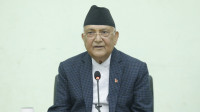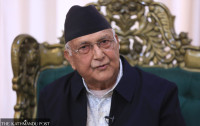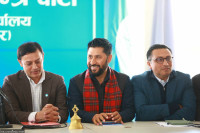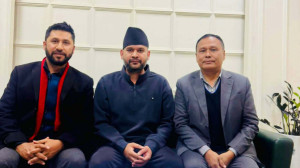Politics
Ruling party fight was for power-sharing and it has become apparent, experts and analysts say
After a truce about two weeks ago, the Nepal Communist Party Secretariat has started discussions on Cabinet reshuffle and political and constitutional appointments.
Tika R Pradhan
Days after a semblance of peace returning to the Nepal Communist Party, the party held its Secretariat meeting on Sunday to “discuss a Cabinet reshuffle”.
Insiders and analysts say the discussions on Cabinet reshuffle were expected to begin any time, as the months-long conflict was largely guided by the factions’ interests rather than “system and procedures”, even though they claimed it to be so.
Along with a Cabinet reshuffle, negotiations are soon likely to start also for some key positions—at constitutional bodies and Nepal’s foreign missions.
“The [Pushpa Kamal] Dahal faction tried hard to establish that the fight was for ensuring a party system but actually it was all about power sharing and this is not hidden to anyone now,” said Mani Thapa, a Standing Committee member. “Everyone knows now that it was much ado about nothing.”
The Nepal Communist Party (NCP) until a few months ago looked headed for a split. The faction led by Dahal, the other chair of the party, backed by senior leaders Madhav Kumar Nepal and Jhala Nath Khanal, was demanding that KP Sharma Oli step down both as party chair and prime minister. Their allegations were that Oli was running both the party and the government unilaterally, not giving two hoots about the party system.
At one point of time, Oli’s position had become tenuous, with as many as 31 out of the 44 Standing Committee members demanding that he resign as party chair and prime minister.
But after weeks of negotiations, Oli and Dahal decided to form a six-member task force to suggest the way forward for the party. The task force suggested that Oli should lead the government for the full five-year term and Dahal should lead the party with an expanded role as “executive chairman”. The crisis then ended in the party.
It was because of the deal that Oli agreed to let the Secretariat meeting take place at Paris Danda–the headquarters of the former Maoists.
“Now it has been established among the people and the party cadres that they fought for their positions and not for the party system,” said Thapa.
Though the Standing Committee meeting that concluded on September 11, after 80 days, saying that the party “managed to iron out all major differences”, insiders were questioning if the leadership indeed had addressed all the outstanding issues and described the “deal” as a ceasefire.
“It was by and large clear that the whole fight was for power sharing and nothing more,” said Lalbabu Pandit, a Central Committee member and former minister who is close to senior leader Nepal, who had supported Dahal in the fight against Oli.
According to Pandit, the party has yet to establish a system and that unless the party leadership follows due procedures, such conflicts could emerge anytime soon.
“Our party is still not functioning under any system,” Pandit told the Post. “There is a conflict among the leadership when it does not suit their interests. When it benefits the leaders, it looks like everything is hunky-dory in the party. That’s not the case.”
The truce in the party, according to insiders, is likely to continue in the party at least until the festive season. There are dissatisfactions all around but with the festivities just round the corner and the Covid-19 pandemic hitting the country hard, the leaders may not fight like cats and dogs for now, they say.
The end of the standoff, in the immediate effect, meant both Oli and Dahal got what they wanted–the former the government and the latter the party. But party leaders say that hardly addresses the concerns of the sub-factions.
The Nepal group is already unhappy with Dahal, as they believe he conveniently sided with Oli, deserting them despite putting up a strong fight. But Nepal and Khanal too have decided to go with the flow hoping that a power-sharing deal will offer something to them too.
With dozens of constitutional and ambassadorial positions vacant, the party is likely to address the Nepal faction’s concerns by giving their loyal leaders some posts, according to insiders. The Nepal group’s grievances could be addressed also during the Cabinet reshuffle, according to insiders.
A larger deal could mean at least two chief ministers for the Nepal faction–in Province 5 and Bagmati. Since the Nepal Communist Party has governments in six of the seven provinces, reshuffles in the Cabinets there are also likely.
One of the major issues for Oli and Dahal will be how to manage Bamdev Gautam, the party’s vice-chair.
Gautam has already been nominated to the National Assembly and he is likely to claim “senior deputy prime minister” along with a “powerful” ministry.
In the meantime, Narayan Kaji Shrestha, the party spokesperson, is also eyeing a ministerial berth along with deputy prime minister.
Leaders say Oli and Dahal will face a tough time managing these two senior leaders. Both Gautam and Shrestha had lost the 2017 parliamentary elections and the party’s decision to take them to the National Assembly has met with criticism.
A central member said though the party seems to have achieved a truce at this time, things are not very easy in the coming days.
“The problem is the party has not been able to give an impression that neither we nor the government led by our party is doing anything in the larger interest of the people,” said Hemraj Bhandari, a central member. “The infighting that continued for months has exposed the party—that the fight was basically for power sharing among the top leaders and their factions.”
According to Bhandari, such activities by the party and the leadership, which wasted crucial time without doing anything to fight the pandemic, will leave a negative impact on the people as well as the party rank and file.
Political analysts say since the ruling communist party is a marriage of convenience, such issues were bound to emerge and even bigger issues like these would surface in the future as well.
“What’s the point of this whole hullabaloo for months?” said Shyam Shrestha, a political analyst who has followed leftist politics for decades. “We knew all along that the fight in the ruling party was always for posts and positions. It was not for the system, not the people and not any ideology. It was all about how they were going to manage the leaders in the party.”
Rajendra Maharjan, also a political commentator who writes a column for Kantipur, the Post’s sister paper, says the problem is that the rival faction might have been pressing for a system but that it also lacks a vision as to how it will do that.
“The rival faction’s focus was on power rather than on how the Oli government was functioning to deal with pressing issues, including the pandemic,” Maharjan told the Post. “Had the ruling party’s fight been for ways to deliver on the promises and addressing people’s sufferings in the wake of Covid-19 and natural disasters, it could have earned some praise. It’s sad that they had their sights on power and positions.”




 5.55°C Kathmandu
5.55°C Kathmandu















